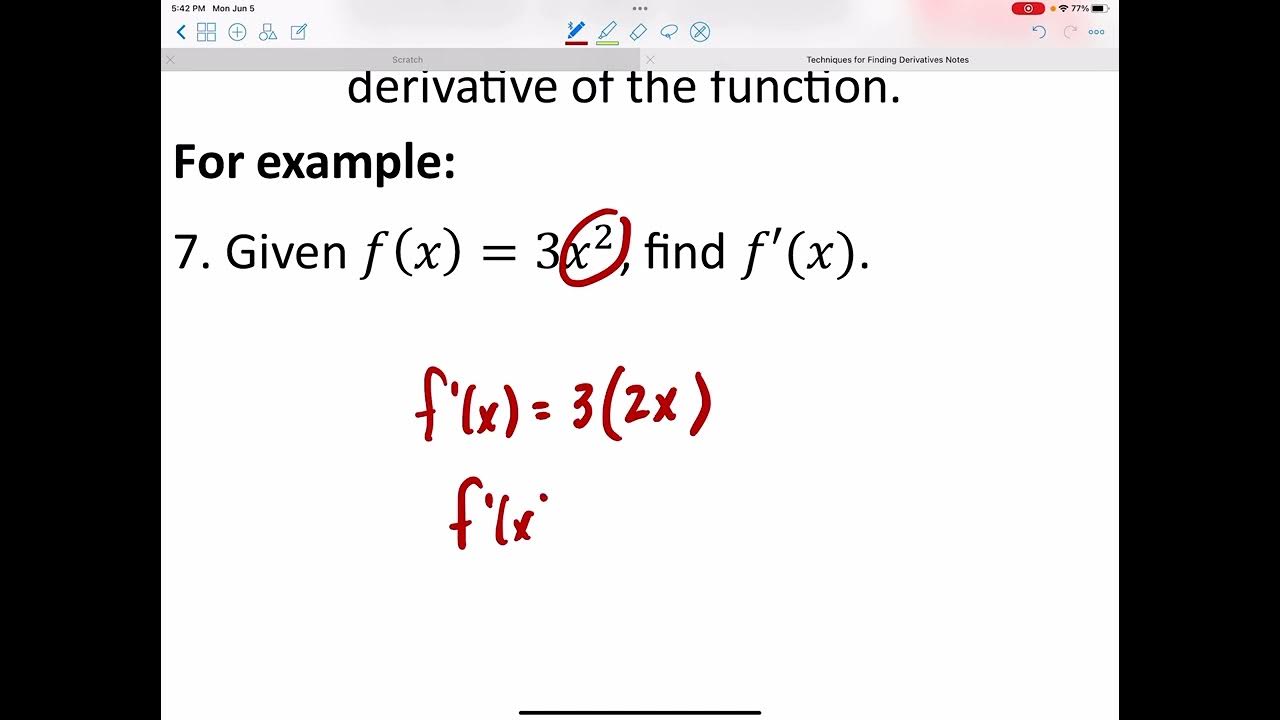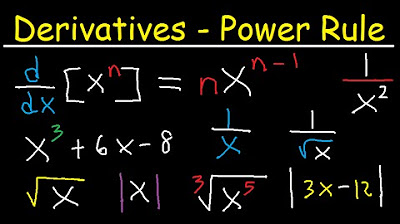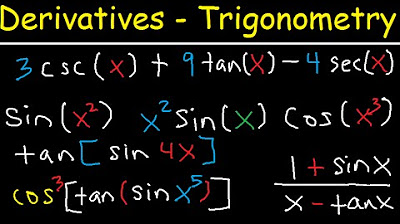Derivative formulas through geometry | Chapter 3, Essence of calculus
TLDRThe video script delves into the concept of derivatives in calculus, emphasizing their importance in analyzing real-world phenomena often modeled by polynomials, trigonometric functions, exponentials, and other pure functions. It aims to move beyond mere memorization of rules, encouraging an intuitive and geometric understanding of derivatives as they relate to tiny changes in quantities. The script explores the derivative computation for simple functions like x squared and x cubed using geometric interpretations, leading to the power rule for polynomial terms. It also examines the derivative of 1/x using a creative water puddle analogy and the sine function through the unit circle concept. The content invites viewers to actively engage with the material, ponder over the expressions, and promises a continuation of the topic in subsequent videos, focusing on derivatives of combined functions.
Takeaways
- 📚 Derivatives are fundamental to calculus and represent the rate of change of a function concerning a small change in its variable.
- 🌟 Understanding derivatives is crucial for analyzing real-world phenomena that are often modeled using polynomials, trigonometric functions, exponentials, and other pure functions.
- 🔍 Derivatives are not just about memorizing rules but about examining how tiny changes in one quantity relate to resulting changes in another.
- 📈 The derivative of a function at a point can be visualized as the slope of the tangent line to the graph of the function at that point.
- 🔢 For the function f(x) = x^2, the derivative represents the rate of change of the area of a square with side length x when the side length is increased by a small amount dx.
- 🟨 When finding the derivative of x^3, the increase in volume of a cube with side length x when the side length is increased by dx is considered, leading to the derivative 3x^2.
- 🆙 The power rule states that the derivative of x to the power of n (x^n) is n times x to the power of n minus 1 (nx^(n-1)) for any real number n.
- 📏 For the function f(x) = 1/x, the derivative can be reasoned geometrically by imagining a rectangle with a constant area of 1 and varying dimensions proportional to x and 1/x.
- 📐 The derivative of the sine function, sin(θ), is the cosine function, cos(θ), which can be understood both graphically and through the unit circle representation of trigonometric functions.
- 🤔 Encouragement is given for learners to pause and ponder over the expressions and reasoning, promoting a deeper understanding of derivatives rather than just applying formulas.
- 🚀 The next steps involve learning how to take derivatives of more complex functions, such as sums, products, and compositions of simple functions, with an emphasis on geometric and intuitive understanding.
Q & A
What is the fundamental concept of a derivative in calculus?
-The fundamental concept of a derivative is to measure the rate at which a quantity changes with respect to another quantity. It is about examining tiny changes in one quantity and how that relates to a resulting tiny change in another quantity.
Why is it important to understand derivatives for real-world phenomena?
-Understanding derivatives is important because many real-world phenomena are modeled using functions like polynomials, trigonometric functions, exponentials, and other pure functions. Grasping the rates of change for these abstract functions provides a language to discuss the rates at which things change in concrete situations that calculus is used to model.
How does the concept of a tangent line relate to derivatives?
-The concept of a tangent line is related to derivatives because the slope of the tangent line to the graph of a function at a particular point is equivalent to the derivative of the function at that point. It represents the rate of change of the function at that point.
What is the geometric interpretation of the derivative of a function like f(x) = x^2?
-The geometric interpretation of the derivative of f(x) = x^2 is the rate of change of the area of a square with side length x when the side length is increased by a tiny amount dx. The derivative represents the increase in area per unit increase in side length.
How does the area of a square relate to the derivative of x squared?
-The derivative of x squared (f(x) = x^2) can be visualized by considering the area of a square with side x. When the side length x is increased by a small amount dx, the change in area (dF) is approximately 2x*dx, which represents the derivative of x^2, or the rate of change of the area with respect to the change in side length.
What is the power rule for derivatives?
-The power rule for derivatives states that the derivative of x to the power of n (x^n) is n times x to the power of n minus 1 (n*x^(n-1)). It is a fundamental rule used to find the derivatives of polynomial terms.
How does the volume of a cube help in understanding the derivative of x cubed?
-The volume of a cube with side length x can be used to understand the derivative of x cubed (f(x) = x^3). When the side length x is increased by a small amount dx, the increase in volume is primarily from three thin square faces, each with an area of x^2*dx, resulting in a total volume change of 3x^2*dx. This leads to the derivative of x^3 being 3x^2.
What is the geometric interpretation of the derivative of 1/x?
-The geometric interpretation of the derivative of 1/x can be visualized using a rectangle with a fixed area of 1, where the width is x and the height is 1/x. When x is increased by a small amount dx, the height must decrease to maintain the area, resulting in a change in height (d(1/x)) that is the negative of the derivative of 1/x.
How can the unit circle help in understanding the derivative of the sine function?
-The unit circle can be used to understand the derivative of the sine function by considering a point on the circle that has traveled an arc length of theta. A small increase d theta in the arc length results in a small change in the height (d sine of theta) above the x-axis. The derivative of sine is the ratio of this change in height to the change in arc length, which geometrically corresponds to the definition of cosine, thus the derivative of sine is cosine of theta.
What is the derivative of the sine function with respect to theta?
-The derivative of the sine function with respect to theta (d(sin(theta))/dx) is the cosine of theta (cos(theta)). This is because the rate of change of the sine function at any point on the unit circle corresponds to the cosine of the angle at that point.
Why is it beneficial to understand derivatives both symbolically and geometrically?
-Understanding derivatives both symbolically and geometrically is beneficial because it allows for a more comprehensive understanding of the concept. Symbolic understanding enables quick computation, while geometric understanding provides an intuitive grasp of what the derivative represents in terms of rates of change, making it easier to remember and apply in various contexts.
Outlines
📚 Understanding Derivatives and Rates of Change
The paragraph introduces the concept of derivatives as a method to calculate the rate of change for a given function. It emphasizes the importance of understanding derivatives for analyzing real-world phenomena, which are often modeled using polynomials, trigonometric functions, exponentials, and other pure functions. The paragraph also cautions against viewing the process as merely memorizing rules, instead advocating for an intuitive and geometric understanding of derivatives. It uses the example of the function f(x) = x^2 to illustrate how to find the derivative by considering the change in area of a square when its side length is increased by a small amount dx.
📈 Derivatives of Polynomials and the Power Rule
This section delves into the geometric interpretation of derivatives for polynomial functions. It explains how the volume of a cube, whose side length is x, changes when x is increased by dx, leading to the conclusion that the derivative of x^3 is 3x^2. The paragraph generalizes this concept to the power rule, stating that the derivative of x to the power of n is n times x to the power of n minus 1. It also discusses how higher powers of dx can be ignored when calculating derivatives, as they become negligible for infinitesimally small changes.
🤔 Geometric Interpretation of Derivatives Beyond Polynomials
The paragraph explores the geometric reasoning behind derivatives for functions beyond simple polynomials. It challenges the reader to consider the derivative of 1/x, or x to the power of -1, by visualizing a rectangle with a fixed area of 1, where the width is x and the height is 1/x. The paragraph also invites the reader to ponder the derivative of the square root of x and to compare the geometric reasoning with applying the power rule symbolically. It then transitions to discussing the derivative of trigonometric functions, specifically focusing on the sine function and its relationship with the unit circle.
📐 Derivatives of Trigonometric Functions: Sine and Cosine
This part of the script focuses on the derivatives of trigonometric functions, using the sine function as an example. It uses the unit circle to explain how the sine of an angle theta is represented as the height of a point on the circle above the x-axis. The paragraph describes how a small change d theta in the angle results in a small change in height, which is the derivative of sine. It is revealed that the derivative of sine is cosine, which is supported by both the graph's shape and the geometric reasoning involving the unit circle. The reader is encouraged to apply similar reasoning to find the derivative of the cosine function.
Mindmap
Keywords
💡Derivative
💡Rate of Change
💡Polynomials
💡Trigonometric Functions
💡Exponentials
💡Power Rule
💡Unit Circle
💡Tangent Line
💡Geometric Interpretation
💡Tiny Nudges
💡Function Composition
Highlights
Derivatives are fundamentally about looking at tiny changes to some quantity and how that relates to a resulting tiny change in another quantity.
Real-world phenomena are often modeled using polynomials, trigonometric functions, exponentials, and other pure functions.
The derivative of a function can be visualized as the slope of the tangent line to the graph of the function.
For f(x) = x^2, the derivative can be interpreted as the rate of change in the area of a square with side length x.
When taking the derivative, terms involving dx squared or higher can be ignored for truly tiny dx.
The derivative of x^n for any power n is n times x to the power of n-1, known as the power rule.
The power rule can be understood geometrically by considering the expansion of (x + dx)^n.
For f(x) = 1/x, the derivative can be reasoned about geometrically by considering the height of a rectangle with area 1 and width x.
The derivative of the sine function, sin(theta), can be understood by considering the unit circle and the change in height as theta increases.
The derivative of sin(theta) is cos(theta), which can be seen both graphically and by considering the unit circle.
The derivative provides a way to analyze the rates of change in real-world phenomena modeled by functions.
Building fluency with derivatives of pure abstract functions enables more readily talking about rates of change in concrete situations.
The geometric view of the volume of a cube helps understand the derivative of x^3 as 3x^2.
The power rule for derivatives can be derived by considering the expansion of (x + dx)^n and ignoring higher order terms.
Visualizing the derivative of 1/x geometrically as the height change of a rectangle with area 1 provides insight into the derivative being -1/x^2.
Derivatives of functions that combine simple functions can be understood by considering the geometric and graphical properties of each function.
The derivative of the cosine function, cos(theta), can be found by similar reasoning as for sin(theta), considering the unit circle and the change in height as theta increases.
Transcripts
Browse More Related Video

Chain Rule: the Derivative of a Composition

Techniques for Finding Derivatives

Power rule introduction (old) | Taking derivatives | Differential Calculus | Khan Academy

Quotient rule and common derivatives | Taking derivatives | Differential Calculus | Khan Academy

Derivatives - Power Rule

Derivatives of Trigonometric Functions - Product Rule Quotient & Chain Rule - Calculus Tutorial
5.0 / 5 (0 votes)
Thanks for rating: